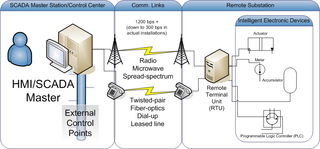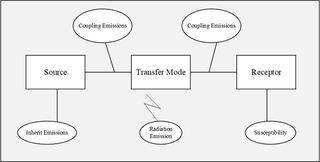Related Research Articles
In electrical engineering, partial discharge (PD) is a localized dielectric breakdown (DB) of a small portion of a solid or fluid electrical insulation (EI) system under high voltage (HV) stress. While a corona discharge (CD) is usually revealed by a relatively steady glow or brush discharge (BD) in air, partial discharges within solid insulation system are not visible.
MARC is a standard set of digital formats for the machine-readable description of items catalogued by libraries, such as books, DVDs, and digital resources. Computerized library catalogs and library management software need to structure their catalog records as per an industry-wide standard, which is MARC, so that bibliographic information can be shared freely between computers. The structure of bibliographic records almost universally follows the MARC standard. Other standards work in conjunction with MARC, for example, Anglo-American Cataloguing Rules (AACR)/Resource Description and Access (RDA) provide guidelines on formulating bibliographic data into the MARC record structure, while the International Standard Bibliographic Description (ISBD) provides guidelines for displaying MARC records in a standard, human-readable form.
Electric power quality is the degree to which the voltage, frequency, and waveform of a power supply system conform to established specifications. Good power quality can be defined as a steady supply voltage that stays within the prescribed range, steady AC frequency close to the rated value, and smooth voltage curve waveform. In general, it is useful to consider power quality as the compatibility between what comes out of an electric outlet and the load that is plugged into it. The term is used to describe electric power that drives an electrical load and the load's ability to function properly. Without the proper power, an electrical device may malfunction, fail prematurely or not operate at all. There are many ways in which electric power can be of poor quality, and many more causes of such poor quality power.
Software quality assurance (SQA) is a means and practice of monitoring all software engineering processes, methods, and work products to ensure compliance against defined standards. It may include ensuring conformance to standards or models, such as ISO/IEC 9126, SPICE or CMMI.

Distributed Network Protocol 3 (DNP3) is a set of communications protocols used between components in process automation systems. Its main use is in utilities such as electric and water companies. Usage in other industries is not common. It was developed for communications between various types of data acquisition and control equipment. It plays a crucial role in SCADA systems, where it is used by SCADA Master Stations, Remote Terminal Units (RTUs), and Intelligent Electronic Devices (IEDs). It is primarily used for communications between a master station and RTUs or IEDs. ICCP, the Inter-Control Center Communications Protocol, is used for inter-master station communications. Competing standards include the older Modbus protocol and the newer IEC 61850 protocol.
In systems engineering and requirements engineering, a non-functional requirement (NFR) is a requirement that specifies criteria that can be used to judge the operation of a system, rather than specific behaviours. They are contrasted with functional requirements that define specific behavior or functions. The plan for implementing functional requirements is detailed in the system design. The plan for implementing non-functional requirements is detailed in the system architecture, because they are usually architecturally significant requirements.
A software design description is a representation of a software design that is to be used for recording design information, addressing various design concerns, and communicating that information to the design’s stakeholders. An SDD usually accompanies an architecture diagram with pointers to detailed feature specifications of smaller pieces of the design. Practically, the description is required to coordinate a large team under a single vision, needs to be a stable reference, and outline all parts of the software and how they will work.
The Common Information Model (CIM) is an electric power transmission and distribution standard developed by the electric power industry. It aims to allow application software to exchange information about an electrical network. It has been officially adopted by the International Electrotechnical Commission (IEC).

A phasor measurement unit (PMU) is a device used to estimate the magnitude and phase angle of an electrical phasor quantity in the electricity grid using a common time source for synchronization. Time synchronization is usually provided by GPS or IEEE 1588 Precision Time Protocol, which allows synchronized real-time measurements of multiple remote points on the grid. PMUs are capable of capturing samples from a waveform in quick succession and reconstructing the phasor quantity, made up of an angle measurement and a magnitude measurement. The resulting measurement is known as a synchrophasor. These time synchronized measurements are important because if the grid’s supply and demand are not perfectly matched, frequency imbalances can cause stress on the grid, which is a potential cause for power outages.
Instrument control consists of connecting a desktop instrument to a computer and taking measurements.

The Standard Commands for Programmable Instruments defines a standard for syntax and commands to use in controlling programmable test and measurement devices, such as automatic test equipment and electronic test equipment.
The FIATECH AEX cfiXML schemas have been developed to automate information exchange for the design, procurement, delivery, installation, operation and maintenance of engineered equipment. Though large companies may have internal software integration systems, data exchange between collaborating companies commonly requires labor-intensive and costly re-entry of data into in-house systems. AEX cfiXML schemas provide a standard language to enable interoperability, allowing information flow to and from multiple software systems within a company or with other companies. The potential annual savings for capital facility industries are millions of dollars.
COMTRADE is a file format for storing oscillography and status data related to transient power system disturbances.
A distribution management system (DMS) is a collection of applications designed to monitor and control the electric power distribution networks efficiently and reliably. It acts as a decision support system to assist the control room and field operating personnel with the monitoring and control of the electric distribution system. Improving the reliability and quality of service in terms of reducing power outages, minimizing outage time, maintaining acceptable frequency and voltage levels are the key deliverables of a DMS. Given the complexity of distribution grids, such systems may involve communication and coordination across multiple components. For example, the control of active loads may require a complex chain of communication through different components as described in US patent 11747849B2
ISO/IEEE 11073 Personal Health Device (PHD) standards are a group of standards addressing the interoperability of personal health devices (PHDs) such as weighing scales, blood pressure monitors, blood glucose monitors and the like. The standards draw upon earlier IEEE11073 standards work, but differ from this earlier work due to an emphasis on devices for personal use and a simpler communications model.
A voltage sag or voltage dip is a short-duration reduction in the voltage of an electric power distribution system. It can be caused by high current demand such as inrush current or fault current elsewhere on the system.
A severity factor is established as a coefficient to assess the dielectric severity supported by a transformer winding considering the incoming transient overvoltage. It determines the safety margin regarding to the standard acceptance tests either in the frequency or time domain.
Daniel Douglas Sabin from Danvers, Massachusetts, USA was named Fellow of the Institute of Electrical and Electronics Engineers (IEEE) in 2016 for leadership in power quality database management and analysis software. He was a principal engineer with Electrotek Concepts when he was elevated to Fellow.

Conducted emissions are the effects in power quality that occur via electrical and magnetic coupling, electronic switch of semiconductor devices, which form a part of electromagnetic compatibility issues in electrical engineering. These affect the ability of all interconnected system devices in the electromagnetic environment, by restricting or limiting their intentional generation, propagation and reception of electromagnetic energy.
References
- ↑ "1159.3-2019 - IEEE Recommended Practice for Power Quality Data Interchange Format (PQDIF)". standards.ieee.org. Retrieved 2020-01-07.
- ↑ N., Rathina; Marimuthu, N (2009-12-09). "ENHANCING POWER QUALITY MONITORING USING WIRELESS APPLICATION PROTOCOL ENABLED MOBILE DEVICES" . Retrieved 2020-04-15.
- ↑ Veloso, P.; Lebre, A.; Melo, N. (2011). Development of the EDP's Power Quality monitoring programme. 11th International Conference on Electrical Power Quality and Utilisation. pp. 1–5. doi:10.1109/EPQU.2011.6128886. ISBN 978-1-4673-0378-1. S2CID 43647211.
- ↑ "IEEE 1159.3 PQDIF Task Force". grouper.ieee.org. Retrieved 2020-01-07.
- ↑ "1159-2019 - IEEE Recommended Practice for Monitoring Electric Power Quality". standards.ieee.org. Retrieved 2020-01-07.
- ↑ "1159.3-2003 - IEEE Recommended Practice for the Transfer of Power Quality Data". standards.ieee.org. Retrieved 2020-01-07.
- ↑ Sabin, Daniel; Dabbs, William (2012-06-15). "Revision of IEEE Std 1159.3 PQDIF" (PDF). 23rd International Conference and Exhibition on Electricity Distribution. 1: 0253 – via CIRED.
- ↑ King, Jack; Gunther, Erich (2006). "COMTRADE / PQDIF Conversion". 2005/2006 Pes Td. pp. 359–364. doi:10.1109/TDC.2006.1668518. ISBN 0-7803-9194-2. S2CID 26958691.
- ↑ Dabbs, William; Sabin, Daniel (2004). "Representation of IEEE STD 1159.3-2002 PQDIF in extensible markup language (XML)". IEEE Power Engineering Society General Meeting, 2004. Vol. 2. IEEE. pp. 510–515. doi:10.1109/pes.2004.1372852. ISBN 0-7803-8465-2. S2CID 31709598.